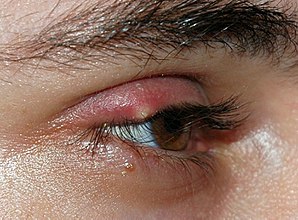Stye
| Stye | |
|---|---|
| Synonyms | sty, hordeolum |
 |
|
| An external stye on the upper eyelid | |
| Pronunciation | stye /ˈstaɪ/ hordeolum /hɔːrˈdiːələm/ |
| Classification and external resources | |
| Specialty | Ophthalmology |
| ICD-10 | H00.0 |
| ICD-9-CM | 373.11 |
| DiseasesDB | 12583 |
| MedlinePlus | 001009 |
| eMedicine | emerg/755 |
| MeSH | D006726 |
Stye, also known as hordeolum, is an infection of an oil gland in the eyelid. This results in a red tender bump at the edge of the eyelid. The outside or the inside of the eyelid can be affected.
The cause of a stye is usually a bacterial infection by Staphylococcus aureus. The internal ones are due to infection of the meibomian gland while the external ones are due to an infection of the gland of Zeis. A chalazion on the other hand is a blocked oil gland without infection. They are typically in the middle of the eyelid and non painful.
Often a stye will go away without any specific treatment in a few days or weeks. Recommendations to speed improvement include warm compresses. Occasionally antibiotic eye ointment may be recommended. While these measures are often recommended evidence to support them is poor. The frequency at which they occur is unclear. They may happen at any age.
The first sign of a stye is a small, yellowish spot at the center of the bump that develops as pus and expands in the area.
Other stye symptoms may include:
Stye complications occur in very rare cases. However, the most frequent complication of styes is progression to a chalazion that causes cosmetic deformity, corneal irritation, and often requires surgical removal. Complications may also arise from the improper surgical lancing, and mainly consist of disruption of lash growth, lid deformity or lid fistula. Styes that are too large may interfere with one's vision.
Eyelid cellulitis is another potential complication of eye styes, which is a generalized infection of the eyelid. Progression of a stye to a systemic infection (spreading throughout the body) is extremely rare, and only a few instances of such spread have been recorded.
Although styes are harmless in most cases and complications are very rare, styes often recur. They do not cause intraocular damage, meaning they do not affect the eye. Styes normally heal on their own by rupturing within a few days to a week causing the relief of symptoms, but if it does not improve or it worsens within two weeks, a doctor's opinion should be sought. Few people require surgery as part of stye treatment. With adequate treatment, styes tend to heal quickly and without complications.
...
Wikipedia
